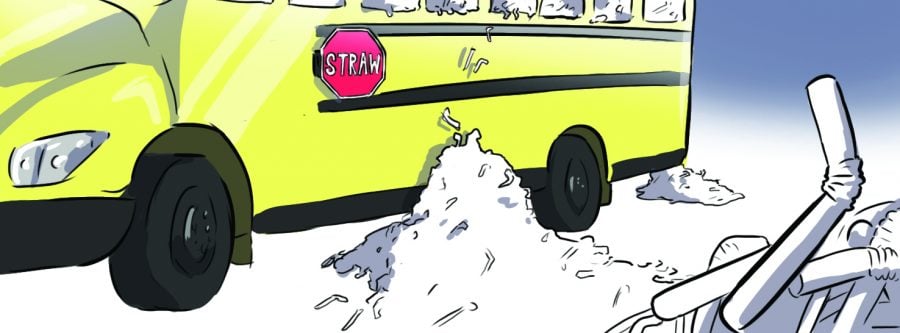Guilford should say goodbye to plastic straws
Let me set the scene for you. You’re at a restaurant. Your server brings you a glass of ice water and sets a straw on the table. You nod gratefully, unwrap the straw and use it to sip your drink.
This action may seem insignificant and commonplace, but according to the National Parks Service, Americans use 500 million straws daily, enough straws to fill more than 125 school buses every day. When this many straws are used, there are significant and detrimental environmental effects.
Though a small contributor to the 8 million tons of plastic that flow into the world’s oceans every year, plastic straws are particularly insidious. Seabirds can ingest plastic straws, often choking and suffocating on them. Additionally, straws can entangle marine animals, or as displayed in a 2015 viral video, become stuck in the nostrils of sea turtles.
Thankfully, Guilford has made strides toward reducing straw use on campus. A few years ago, straws were removed from the cafeteria. This is a step in the right direction. However, there is more that needs to be done.
The Grill still uses plastic straws, despite its environmentally-friendly initiatives, such as the use of recyclable cups.
While it is clear that eating options like The Grill need to have straws since students often take their food and drink to go, these straws don’t have to be made of plastic. There are viable alternatives to plastic straws that Guilford could easily and inexpensively implement. In addition, removing plastic straws from The Grill would further enhance Guilford’s dedication to sustainability and environmentalism.
One alternative to traditional plastic straws are reusable metal straws. Organizations such as Reconsidered Goods, a Greensboro nonprofit and creative reuse center, is hosting a Straw Wars event in celebration of Guilford Creek Week on March 21. At this event, attendees will be provided with reusable steel straws and materials to make and decorate carrying cases for their straws.
Guilford could host an event like this on campus, offering students free reusable straws, supplies for creating carrying cases for them and the opportunity to learn about sustainability. While this event wouldn’t eliminate plastic straw use on campus since not every student would attend or carry their straw with them, it would certainly help to reduce plastic waste.
One downside to this option is its cost. Reusable steel straws are significantly more expensive than single-use plastic straws. However, other alternatives to plastic straws, such as paper straws, are more economically viable.
Companies such as Aardvark Straws manufacture single-use paper straws that are fully compostable. According to the company’s website, Aardvark’s paper straws cost approximately $0.01 more per straw than traditional plastic straws. A campus-wide shift from plastic to paper straws would be not only environmentally friendly, but relatively inexpensive.
While I applaud Guilford for its current environmental initiatives, such as its donation of leftover dining hall food to organizations working to improve food security and its participation in the annual RecycleMania competition, I strongly believe that more can be done in the name of sustainability and environmentalism. Reducing or eliminating plastic straw use on campus would be simple, effective and inexpensive.
Let’s make Guilford greener, one straw at a time.










Kim Burke • Apr 2, 2018 at 6:03 pm
While I commend the idea of getting rid of plastic straws, I just want to remind you that not all people can go without a straw. There are some physical conditions that make it necessary for the use of a straw. Just be sure to keep a few handy for those folks.
Diane Button • Mar 17, 2018 at 11:17 pm
Instead of stainless steel straws, how about paper or waxed paper straws? When I was a kid that’s what we had. We didn’t suffer. We didn’t suck on drinks all day long like the kids nowadays.